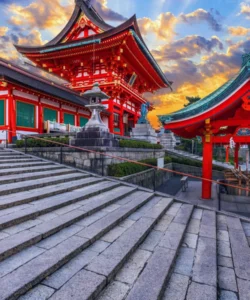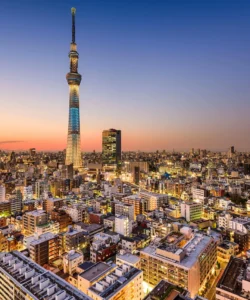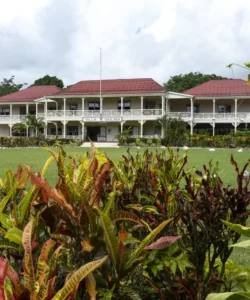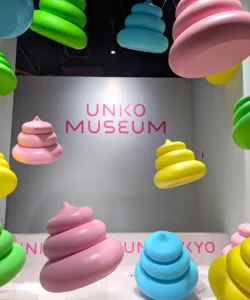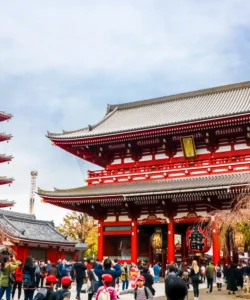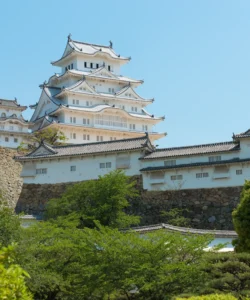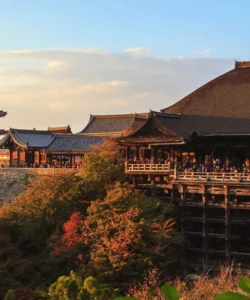Kinkaku-ji (金閣寺), officially known as Rokuon-ji (鹿苑寺, Deer Garden Temple), is one of Japan’s most iconic and visually stunning Zen Buddhist temples. Located in northern Kyoto, it is famous for its magnificent Golden Pavilion, a shining testament to Japanese aesthetic and architectural prowess. It is one of the seventeen sites that comprise the “Historic Monuments of Ancient Kyoto” UNESCO World Heritage Site.
Address:
1 Kinkakuji-cho, Kita-ku, Kyoto 603-8361, Japan. It is easily accessible by public bus from Kyoto Station and other parts of the city.
Outstanding Features:
- The Golden Pavilion (Kinkaku): This three-story pavilion is the undisputed centerpiece and namesake of the temple. Its top two floors are entirely covered in brilliant gold leaf, shimmering spectacularly, especially on sunny days or when reflected in the surrounding Kyoko-chi (Mirror Pond). The pavilion serves as a shariden, housing sacred relics of the Buddha.
- Diverse Architectural Styles: The Golden Pavilion is a unique blend of three distinct architectural styles, each representing a different era and social class:
- First Floor (Shinden-zukuri): Modeled after the palace buildings of the Heian Period aristocracy, characterized by natural wood pillars and white plaster walls.
- Second Floor (Buke-zukuri): Built in the style of samurai residences from the Kamakura Period, its exterior is completely covered in gold leaf.
- Third Floor (Zenshu-butsuden-zukuri): Designed in the style of a Chinese Zen Buddhist hall, it is also gilded inside and out and topped with a golden phoenix ornament.
- Kyoko-chi (Mirror Pond) and Garden: The Golden Pavilion is strategically positioned at the edge of the large, tranquil Kyoko-chi Pond. The pond is meticulously designed with various small islands, rocks, and carefully pruned trees, creating a stunning backdrop and a perfect reflection of the pavilion on its surface, an essential element of traditional Japanese stroll gardens from the Muromachi period.
- Historical Significance: Originally built in 1397 as the retirement villa (Kitayamadono) of Ashikaga Yoshimitsu, the third shogun of the Muromachi period, it was converted into a Zen temple of the Rinzai sect after his death in 1408, as per his will. It represents the lavish “Kitayama culture” that flourished during Yoshimitsu’s time.
- Resilience and Reconstruction: Kinkaku-ji has a tumultuous history, having burned down multiple times, including during the Ōnin War in the 15th century and, most notably, in 1950 by a fanatic monk (an event dramatized in Yukio Mishima’s novel, “The Temple of the Golden Pavilion”). The current structure was rebuilt in 1955 and subsequently re-gilded and renovated, ensuring its continued splendor.
- Surrounding Gardens and Teahouse: Beyond the main pavilion, the temple grounds include traditional Japanese gardens that have largely retained their original Muromachi-period design. Visitors can also see the Sekkatei Teahouse (added in the Edo Period) and Fudo Hall, which houses a statue of Fudo Myoo.
Comparison with Similar Locations:
Kinkaku-ji is often compared to other prominent temples in Kyoto, especially its “sister” temple, Ginkaku-ji:
- Kinkaku-ji vs. Ginkaku-ji (Silver Pavilion):
- Gold vs. Silver: The most obvious contrast. Kinkaku-ji literally shines with gold leaf, representing an opulent and powerful aesthetic. Ginkaku-ji, while not actually covered in silver, embodies a more subdued, rustic, and refined aesthetic of wabi-sabi, typical of the Higashiyama culture.
- Architectural Focus: Kinkaku-ji’s main draw is undeniably its gilded pavilion. Ginkaku-ji, while having a beautiful main hall, is arguably more famous for its meticulously crafted dry sand garden (“Sea of Silver Sand” and “Moon-Viewing Platform”) and moss garden.
- Atmosphere: Kinkaku-ji is often bustling with crowds, drawn by its striking appearance. Ginkaku-ji, particularly when less crowded, tends to offer a more tranquil and contemplative atmosphere.
- Purpose: Both were originally retirement villas for shoguns and later converted to Zen temples, sharing a similar origin story and Rinzai Zen affiliation.
- Kinkaku-ji vs. Byodo-in Temple (Uji):
- Era and Style: Kinkaku-ji (Muromachi Period) represents a later architectural style compared to Byodo-in (Heian Period), particularly its Phoenix Hall (Ho-o-do) built in 1053. Byodo-in is depicted on the 10-yen coin and is a rare surviving example of Heian period Buddhist architecture with Pure Land Buddhist influences, featuring intricate carvings and a distinct, symmetrical layout.
- Function: While Kinkaku-ji houses relics and was a shogun’s villa, Byodo-in was fundamentally designed to evoke the Buddhist paradise of the Pure Land, with its iconic hall standing on an island in a pond.
- Gilding: While Kinkaku-ji is externally gold-covered, Byodo-in’s interior once boasted rich paintings and decorations, and its phoenix statues are a key feature.
- General Kyoto Temples: Many Kyoto temples (like Kiyomizu-dera, Ryoan-ji, etc.) are renowned for their traditional wooden architecture, serene gardens, and spiritual ambiance. Kinkaku-ji stands out among them for its dramatic visual impact, the sheer extravagance of its gold leaf, and its perfectly framed reflection, making it one of the most photographed and immediately recognizable landmarks in all of Japan. Its continuous restoration efforts maintain its historical accuracy while ensuring its dazzling appearance.


